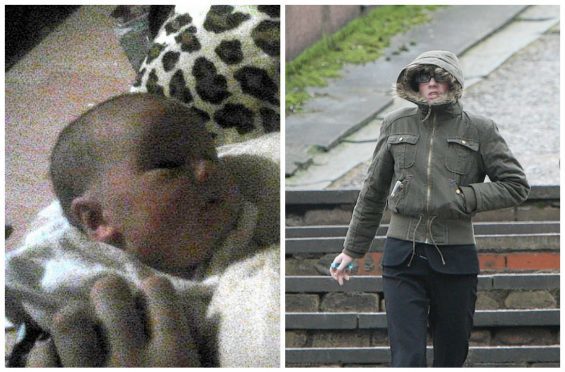Tragic toddler Clyde Campbell had no contact with his “named person” in the year and a half leading up to his death – after his uncaring mother told them to stop visiting.
The two-year-old died of cot death after five months of neglect at the hands of Amanda Hardie, who stayed at a boyfriend’s house the night before he died.
The SNP claimed just a few weeks ago that Clyde’s case “underlined the need” for its controversial state guardian scheme to be rolled out nationwide.
But a Press and Journal investigation has found that the named person – a health visitor – overseeing the welfare of the Inverness youngster only got in touch with the family four times.
The unnamed official visited the home of Hardie twice in the first month of little Clyde’s life in 2012.
After that there were just two further contacts, in April and August of that year, both of which were phone calls, and only one of which was answered.
In response to a message left during the final call on August 8, 2012, Hardie told the named person that she did not want any further visits.
That was enough to ensure the family was not contacted again by the named person until after Clyde was found dead in his home more than 17 months later, on February 23, 2014.
Campaigners claimed last night that the revelations raised “serious questions” about the Named Person policy – but the Scottish Government insisted the controversial scheme was “widely supported”.
Last month, Hardie was sentenced to 10 months in jail after pleading guilty to wilfully ill-treating, abandoning, neglecting and exposing Clyde to unnecessary suffering or injury.
She admitted leaving him unattended and without adult supervision for prolonged periods and, on the evening before his body was found, had worked a shift at a city nightclub before spending the night at her boyfriend’s home.
After she admitted the neglect in March, an SNP spokesman told the Press and Journal that the case highlighted the need for the named person scheme, which has been operating in the Highlands since 2010, and is due to be rolled out nationwide in a few weeks.
It can also be revealed today that Clyde was never assessed as being at risk of significant harm or placed on the child protection register.
He was not on the register despite both mum Hardie and dad Kevin Campbell having convictions for violence.
Highland Council social work chiefs revealed last night that a review was under way into Clyde’s tragic death – but insisted that staff other than the named person had been working with the family in the lead-up to his death, including police, hospital staff, children’s services and his nursery.
But Simon Calvert, from the No to Named Persons (NO2NP) campaign, said: “It is proper to ask whether the named person scheme in Highland is helping or hindering them in the crucial job of identifying at risk children.
“A lot of praise has been lavished on Highland’s named person in order to try to convince an unwilling public to accept the controversial scheme due to be rolled out nationally in August.
“When so much has been made of the scheme – and the Highland scheme in particular – it must be right to expose it to a proper degree of scrutiny not least when there is a case like this that raises serious questions about child protection in Highland.”
Bill Alexander, Highland Council’s director of care and learning, said further intervention by care staff would not have prevented Clyde’s death because he died of cot death.
However, he added: “The case review will enable us to reflect on the level of our interventions relating to Ms Hardie.
“It is already clear that she was avoiding engagement with services. Albeit social workers and other agencies were already involved with the family, if we knew then what we know now, it is very likely that compulsory measures would have been considered necessary.
“This is even though we also know that Ms Hardie’s neglect was not a factor in Clyde’s tragic death.”
Asked about the mother’s decision to cut off contact with the named person, Mr Alexander said: “It (named person) depends on working with consent. It depends on working with a parent who wishes to work with you to support their child.
“If a parent doesn’t wish to work with you to support their child, then you are beyond the named person service. You are talking about other levels of intervention within children’s services.
“Clyde was within other levels of intervention within children’s services.”
Maggie Mellon, a former vice-chairman of the British Association of Social Workers and a former director of the charity Children 1st, said the case gets “right to the heart” of her concerns about the policy, but insisted that the blame should not be placed at the door of the named person.
She said: “The government claims it is just part of their ordinary jobs, but what the government is doing is putting a whole range of people in the public sector as being held responsible.
“Sometimes a person in that role, a health visitor or teacher, will be absolutely crucial in picking things up, that is part of their ordinary jobs. If they do it, great, but it shouldn’t be their responsibility.”
